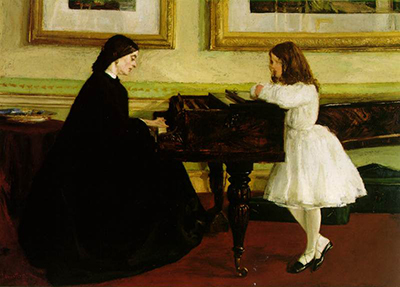James Abbott McNeill Whistler was born in New England in 1834, but spent some of his childhood years in Russia and England, where a relative encouraged the young Whistler's enthusiasm for art.
His artistic development was further enhanced by a spell in Paris as an adult, before he moved to London in 1858, where he produced his second work in the city, At The Piano, the following year. At The Piano shows Whistler's niece and half-sister in their music room in London. Considered to be the artist's first masterpiece, it was displayed initially at the Royal Academy and then in many other exhibitions. One critic praised it for its "feeling for colour", the "power of composition and design", and more appreciation of nature than was usual among artists at that time. This does not mean bright colour, however, but intuitive use of shades, shadows and contrast, with the mother's black dress blending into the dark background, while her daughter's white dress shines with purity, and dominates the composition.
Rembrandt and Velázquez were early influences on Whistler, and with the use of light and attention to realism, that is clear to see here, with typical use of layered applications of oil paint to give substance and depth to the girl's skirt. The view is carefully composed so that the arrangement of picture frames and furniture holds the scene together in a harmony that matches the musical theme. The child gazes at her mother and beyond, while the pianist focuses on the musical instrument and her playing, leaving reflections from the glass on the walls and the polished piano to suggest another world beyond the concentration within this room.
While in Paris, Whistler met the poet Baudelaire and others, and became an advocate for the Aesthetic Movement, with its slogan of "Art for Art's Sake". Over the years, he moved away from realism and towards abstraction, becoming an influence on Manet and Degas in particular. He used musical terms for several series of paintings, terming night-time pictures as Nocturnes to convey his feelings at a particular event or experience, and to suggest what others might be feeling, rather than documenting it exactly. At The Piano, now at the Taft Museum of Art in Cincinatti, is an earlier work with a musical theme that predates impressionism.




